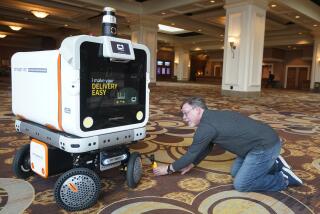‘Smart’ Telephones to Digital Cameras Inundate Crowds at Comdex Show
- Share via
LAS VEGAS — A makeshift museum honoring the microprocessor’s 25th anniversary greeted the throngs attending this week’s Comdex computer trade show here. While the exhibit paid homage to engineering marvels of yesterday--early personal computers like the Commodore PET made possible by the compact chip--industry leaders know they cannot afford to rest on past laurels if they hope to sustain double-digit growth.
The 210,000 attendees at the computer industry’s most important yearly event were treated to 10,000 new products--the equivalent of about 250 per hour--representing the industry’s newest attempts to define its future.
The computer industry has enjoyed a “magical cycle” of revenue, profits, and research and development investment, Andy Grove, chief executive of semiconductor giant Intel Corp., said in a speech that kicked off the weeklong show on Monday.
“My fear is that someday that cycle might sputter,” said Grove, whose recent book, “Only the Paranoid Survive,” accurately represents his world view. “The [PC] might become boring and the new users might not come and then there won’t be the money for technology investment.”
An ominous sign that Grove’s worries will be realized is the recent slowdown in PC sales: After growing 25% in 1995, analysts project U.S. PC sales will drop this year to between 13% and 15%. Computer executives like Grove and Microsoft Chairman Bill Gates know it will take more than a $1,500 Windows PC to win over the nearly two-thirds of American households without a computer. Home PC sales were flat in the third quarter, according to San Jose-based market research firm Dataquest Inc., and only a slight improvement is expected for the holiday season.
Hoping to capture consumer fancy and dollars, computer companies showed off a dizzying array of new machines merging the PC with consumer electronics products such as the telephone and television, and making these hybrids Internet-friendly.
“Smart” telephones and televisions, powered by microprocessors and connected to the Internet, as well as network computers, scaled-down versions of the PC selling for under $1,000, were very much in evidence on the 1.35-million square feet Comdex show floor. Although few of them have made it out of the factory.
Japanese companies, seeing that the convergence of computing with consumer electronics offers them a unique opportunity, were well-represented.
*
“There’s not going to be any one device that’s going to dominate,” maintains Sony Corp. U.S. General Manager Carl Yankowski. “In some homes the nerve center will be the PC, and in others it will be the television.”
Yankowski envisions networked devices such as digital videodiscs that can route their high-quality images to either a PC or television, depending on the consumer’s preference.
Mitsubishi Electronics is another Japanese company bullish on the conversion. “Our products fuse computing and consumer electronics. It really plays to our strengths in technologies like high-quality displays and miniaturization.”
Mitsubishi showed a broad range of Internet-connected devices from computers the size of a palm to big-screen televisions equipped with microprocessors. Whether any of them will find an audience with the stubbornly nontechnical crowd--or will instead be relegated to a future Comdex museum devoted to microprocessor-inspired oddities--is an open question.
Smart phones, which sport a small display to present data downloaded from the Internet as well as poor quality videoconferencing, have been available for more than a year and were widely shown at Comdex. But consumers have ignored them despite their relatively inexpensive $300 price.
Digital cameras that download pictures to either a printer or a PC, where they can be manipulated before being transformed to hard copy, have sold mostly to graphic artists or shutterbugs, but have yet to appeal to a larger market. Some are dubious that they ever will.
“The problem is that most consumers are not ready for the Internet,” said Tim Bajarin, president of Creative Strategies, a Santa Clara consulting firm. “It’s not going to work if the industry tries to shove these information appliances down people’s throats.”




